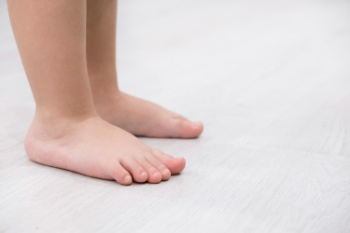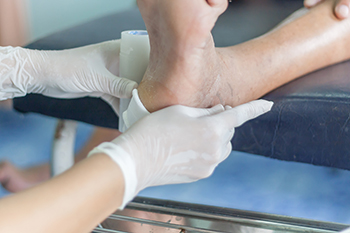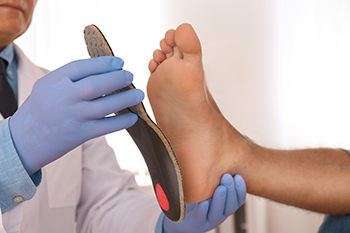Items filtered by date: May 2025
Flat Feet in Children and Teenagers

Flat feet in children and teenagers can be painful, affecting mobility and overall quality of life. This condition occurs when the arches of the feet do not develop properly or collapse under pressure, leading to little or no visible arch. Causes can include genetics, ligament laxity, obesity, injury, or underlying neuromuscular conditions. Overuse and wearing poor footwear can also contribute to discomfort. Symptoms often include aching feet, fatigue during physical activity, inward ankle rolling, and pain in the heels, arches, or lower legs. Some children may also experience stiffness or difficulty walking and running. Early identification and proper management are essential to avoid long-term issues. Treatment may involve stretching, wearing supportive footwear, orthotics, or even surgery. If your child has flat feet that are causing pain and discomfort, it is suggested that you confer with a podiatrist who can offer effective relief tips.
Flatfoot is a condition many people suffer from. If you have flat feet, contact one of our podiatrists from BayCity Associates in Podiatry . Our doctors will treat your foot and ankle needs.
What Are Flat Feet?
Flatfoot is a condition in which the arch of the foot is depressed and the sole of the foot is almost completely in contact with the ground. About 20-30% of the population generally has flat feet because their arches never formed during growth.
Conditions & Problems:
Having flat feet makes it difficult to run or walk because of the stress placed on the ankles.
Alignment – The general alignment of your legs can be disrupted, because the ankles move inward which can cause major discomfort.
Knees – If you have complications with your knees, flat feet can be a contributor to arthritis in that area.
Symptoms
- Pain around the heel or arch area
- Trouble standing on the tip toe
- Swelling around the inside of the ankle
- Flat look to one or both feet
- Having your shoes feel uneven when worn
Treatment
If you are experiencing pain and stress on the foot you may weaken the posterior tibial tendon, which runs around the inside of the ankle.
If you have any questions, please feel free to contact our offices located in Erie, PA and Meadville, PA . We offer the newest diagnostic and treatment technologies for all your foot care needs.
Preventing Foot and Ankle Pain While Running

Foot or ankle pain while running can stem from several causes, including overuse, improper footwear, poor running form, or underlying structural issues. Repetitive impact places stress on the joints, muscles, and tendons, leading to inflammation or irritation. Common conditions include plantar fasciitis, Achilles tendinitis, or stress fractures. Ankle pain may result from instability or tight calf muscles, which place extra strain on the joint. Wearing supportive shoes, warming up properly, and gradually increasing training intensity can help prevent discomfort. Runners benefit from cross-training to strengthen supporting muscles and improve flexibility. Paying attention to pain and allowing time for recovery also plays a key role. When managed proactively, foot and ankle pain does not have to interfere with enjoying or excelling in running. If you have developed this type of pain from running, it is suggested that you consult a podiatrist who can offer effective treatment remedies, and guide you on additional running injury prevention tips.
All runners should take extra precaution when trying to avoid injury. If you have any concerns about your feet, contact one of our podiatrists of BayCity Associates in Podiatry . Our doctors will treat your foot and ankle needs.
How to Prevent Running Injuries
There are a lot of mistakes a runner can make prior to a workout that can induce injury. A lot of athletes tend to overstretch before running, instead of saving those workouts for a post-run routine. Deep lunges and hand-to-toe hamstring pulls should be performed after a workout instead of during a warmup. Another common mistake is jumping into an intense routine before your body is physically prepared for it. You should try to ease your way into long-distance running instead of forcing yourself to rush into it.
More Tips for Preventing Injury
- Incorporate Strength Training into Workouts - This will help improve the body’s overall athleticism
- Improve and Maintain Your Flexibility – Stretching everyday will help improve overall performance
- “Warm Up” Before Running and “Cool Down” Afterward – A warm up of 5-10 minutes helps get rid of lactic acid in the muscles and prevents delayed muscle soreness
- Cross-Training is Crucial
- Wear Proper Running Shoes
- Have a Formal Gait Analysis – Poor biomechanics can easily cause injury
If you have any questions, please feel free to contact our offices located in Erie, PA and Meadville, PA . We offer the newest diagnostic and treatment technologies for all your foot care needs.
We Can Treat Your Foot or Ankle Pain
Custom Orthotics Can Be Used In Stylish Footwear

Who said style can't be comfortable? With Custom Orthotics, you get the best of both worlds. Slip them into your favorite fashionable shoes and feel the difference. They mold to your feet, offering support without compromising on style. No more choosing between looking good and feeling great. With Custom Orthotics, step out in style and comfort every day. Contact our office to learn more!
When Heels Will Not Heal

Heel ulcers can start small but often grow into serious wounds that are slow to recover. These open sores usually appear on the back of the heel and may begin with redness, dryness or thickened skin. People with diabetes or poor circulation are especially at risk, as the skin on their feet can break down more easily. Pressure from walking or shoes that do not fit well can make the problem worse. Over time, the skin may crack, drain or develop a scab that never quite closes. Treatment involves relieving pressure, cleaning the area carefully and often using special dressings or prescribed medications. In more advanced cases, a podiatrist may need to remove dead tissue to encourage healing. If you notice a sore on your heel that does not improve, it is suggested you see a podiatrist for diagnosis and appropriate treatment.
Wound care is an important part in dealing with diabetes. If you have diabetes and a foot wound or would like more information about wound care for diabetics, consult with one of our podiatrists from BayCity Associates in Podiatry . Our doctors will assess your condition and provide you with quality foot and ankle treatment.
What Is Wound Care?
Wound care is the practice of taking proper care of a wound. This can range from the smallest to the largest of wounds. While everyone can benefit from proper wound care, it is much more important for diabetics. Diabetics often suffer from poor blood circulation which causes wounds to heal much slower than they would in a non-diabetic.
What Is the Importance of Wound Care?
While it may not seem apparent with small ulcers on the foot, for diabetics, any size ulcer can become infected. Diabetics often also suffer from neuropathy, or nerve loss. This means they might not even feel when they have an ulcer on their foot. If the wound becomes severely infected, amputation may be necessary. Therefore, it is of the upmost importance to properly care for any and all foot wounds.
How to Care for Wounds
The best way to care for foot wounds is to prevent them. For diabetics, this means daily inspections of the feet for any signs of abnormalities or ulcers. It is also recommended to see a podiatrist several times a year for a foot inspection. If you do have an ulcer, run the wound under water to clear dirt from the wound; then apply antibiotic ointment to the wound and cover with a bandage. Bandages should be changed daily and keeping pressure off the wound is smart. It is advised to see a podiatrist, who can keep an eye on it.
If you have any questions please contact our offices located in Erie, PA and Meadville, PA . We offer the newest diagnostic and treatment technologies for all your foot and ankle needs.
When to Begin Wearing Post Operative Foot Orthotics

Post operative foot orthotics play a key role in recovery from foot and ankle surgery by providing support, alignment, and protection during the healing process. Patients are typically advised to begin wearing orthotics once the initial healing phase has passed and their podiatrist has confirmed that weight-bearing is safe. At this stage, orthotics help redistribute pressure, reduce strain on healing tissues, and guide proper foot function. They also assist in preventing complications like abnormal gait patterns or recurrence of deformities. Timing can vary depending on the procedure and individual healing rates, so it is important for patients to follow personalized recommendations from their podiatrist. If you are recovering from foot surgery, it is suggested that you confer with your podiatrist who can advise you on the best time to begin wearing post-operative foot orthotics.
Custom orthotics can be an important solution for reducing foot pain by targeting its structural causes rather than just the symptoms. When the feet are misaligned, excess strain develops in the muscles, tendons, and ligaments, often resulting in discomfort in the arches, balls of the feet, or toes. Orthotics are designed to match each foot’s natural shape, supporting proper alignment and evenly distributing pressure to ease pain and improve movement.
Foot pain is commonly caused by overuse, wearing improper footwear, or biomechanical issues that place added stress on sensitive areas. By stabilizing the foot and restoring natural motion, custom orthotics help reduce strain, calm inflammation, and promote healing. Many patients experience lasting relief and greater comfort while walking, standing, or exercising.
Created from a detailed assessment using advanced imaging or casting, each pair of orthotics is tailored to your individual needs. If you are experiencing ongoing foot pain, it is suggested that you contact our office for an evaluation and treatment.
If you have any questions, please feel free to contact our offices located in Erie, PA and Meadville, PA .
Causes of Pain in the Big Toe Joint

Pain in the big toe joint, or first metatarsophalangeal joint, may result from a variety of conditions that affect the bones and soft tissue structures of the forefoot. This joint links the long bone of the foot to the base of the big toe and bears significant stress during walking and running. Common causes of pain in the big toe joint include bunions, arthritis, gout, metatarsalgia, and turf toe. A bunion can result when the top of the big toe shifts toward the second toe, causing the bottom of the toe to shift away from the foot. Arthritis, including osteoarthritis and inflammatory types, can damage the joint cartilage, leading to stiffness and pain. Gout, another form of arthritis, may produce sudden swelling due to uric acid crystal deposits in the big toe joint. Turf toe, common in athletes and dancers, may occur from forced upward bending of the toe. A podiatrist can evaluate the underlying cause of your big toe joint pain and may recommend surgery when other methods are not effective. If you have pain in the joint of your big toe, it is suggested that you schedule an appointment with a podiatrist for appropriate treatment.
Toe pain can disrupt your daily activities. If you have any concerns, contact one of our podiatrists of BayCity Associates in Podiatry . Our doctors can provide the care you need to keep you pain-free and on your feet.
What Causes Toe Pain?
Most severe toe pain is caused due to a sports injury, trauma from dropping something heavy on the toe, or bumping into something rigid. Other problems can develop over time for various reasons.
Toe pain can be caused by one or more ailments. The most common include:
- Trauma
- Sports injury
- Wearing shoes that are too tight
- Arthritis
- Gout
- Corns and calluses
- Hammertoe
- Bunions
- Blisters
- Ingrown toenails
- Sprains
- Fractures (broken bones)
- Dislocations
When to See a Podiatrist
- Severe pain
- Persistent pain that lasts more than a week
- Signs of infection
- Continued swelling
- Pain that prevents walking
Diagnosis
In many cases the cause of toe pain is obvious, but in others, a podiatrist may want to use more advanced methods to determine the problem. These can range from simple visual inspections and sensation tests to X-rays and MRI scans. Prior medical history, family medical history, and any recent physical traumatic events will all be taken into consideration for a proper diagnosis.
Treatment
Treatments for toe pain and injuries vary and may include shoe inserts, padding, taping, medicines, injections, and in some cases, surgery. If you believe that you have broken a toe, please see a podiatrist as soon as possible.
If you have any questions please contact our offices located in Erie, PA and Meadville, PA . We offer the newest diagnostic and treatment technologies for all your foot and ankle needs.

